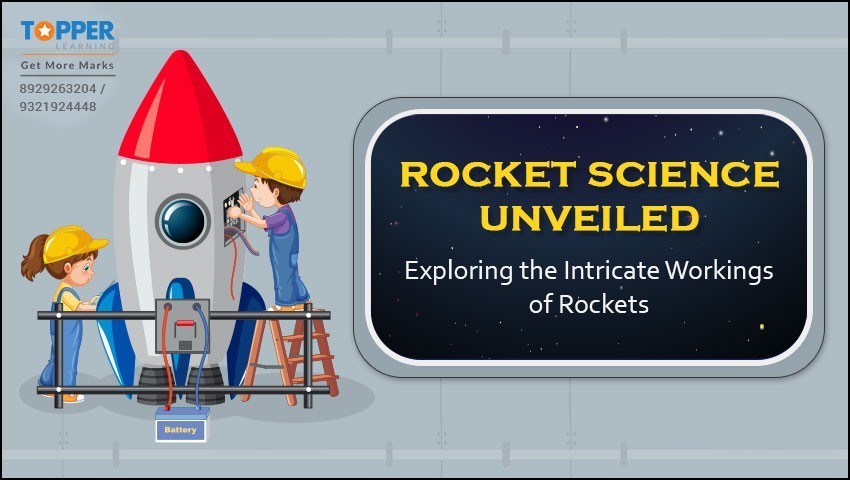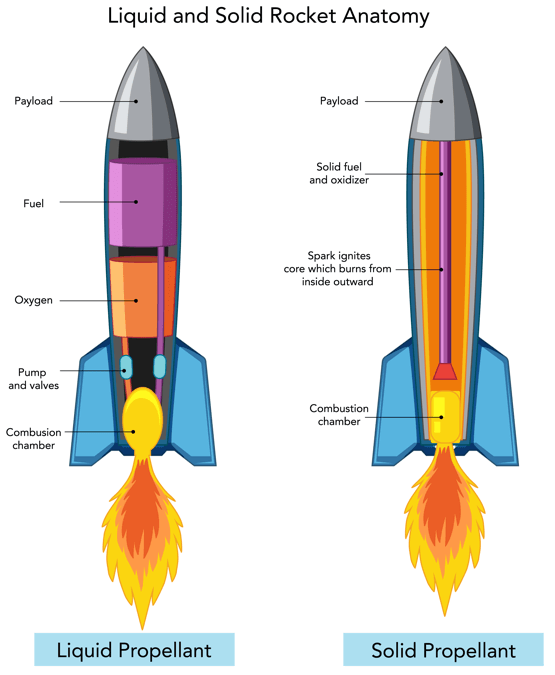Rocket Science Unveiled: Exploring the Intricate Workings of Rockets

This blog aims to explore the history, working principle, and many fascinating facts about rocket propulsion, as well as to learn more about the Indian Space Research Organization's (ISRO) accomplishments and future plans.
By Topperlearning Expert 04th Sep, 2023 | 04:39 pm
ShareIntroduction to Rockets
I am sure many of us dreamed of becoming astronauts or travelling to space as children. Moreover, perhaps some of us already know what a rocket is. We will try to look at Rockets' history, working principles, and many other aspects through this blog. Rockets are vehicles explicitly designed to travel into space. They move at incredible speeds through the Earth's atmosphere using Newton's law of motion, and the exhaust gases created by burning fuel give the necessary push for the rocket to lift off.
Although the working principle of rockets has been known to humans for over two thousand years, we have only lately been able to grasp their complete potential.
History of Rockets:
A little bird-shaped device was one of the early inventions that utilized rocket propulsion technology. The bird's belly housed a boiler that heated the water and converted it to steam. The steam would flow from the nozzle at the rear end, propelling the bird.
Archytas (428-347 BC), a Greek philosopher, mathematician, and astronomer, is credited with designing and flying this device. Based on a similar idea, he created the Aeolipile, also known as Hero's engine, which consists of a metal sphere fitted over a water kettle that rotates due to steam produced and released at two opposing ends, as shown below.
Another essential invention in the history of humanity was Gunpowder. Although its exact origin is still unknown, some historians claim it was first invented in China. It was a ritualistic concoction of saltpetre, sulphur, and charcoal. Bamboo tubes were sealed and thrown into flames, resulting in a burst of light and a loud roar. Sometimes, the sealed ends break, realizing hot gases and propelling them forward at high speed. Using these phenomena, in 1232 AD, the Chinese hooked these tubes to arrows and used them against the Mongols in the battle of Kai-Keng, thereby giving birth to the rocket. Later, during the 18th and 19th centuries, rocket technology was widely used worldwide as a weapon of choice.
Birth of Modern Rocketry:
Sir Isaac Newton, an English mathematician and physicist, first proposed his theory "Philosophiae Naturalis Principia Mathematica" ("Mathematical Principles of Natural Philosophy") in the 17th century, which changed the field of physics completely and gave birth to modern rocketry. These laws further helped in the development of science and technology.
Around the 19th and 20th centuries, the prospect of using rockets sparked curiosity among academics and the public due to the arms race during World War. Later, in 1926, American physicist Robert Goddard was the first to test a functional prototype of a liquid-fuelled rocket, which reached a height of 41 feet and travelled 184 feet.
Also, the two well-known figures in the field of rocketry "Hermann Oberth and Werner van Braun, German scientists" who had critical roles in developing rocket propulsion systems for the Nazi government during World War II, are well-known names in the field of rocketry. V2 rockets, the most advanced rocket at the time, were developed by Werner van Braun and eventually aided in constructing American rockets after surrendering to Allied forces at the war's end.
How Rockets Work?
Rocket is a modern technological marvel made possible by decades of scientific advancement. So, let us see the structure of rockets.
A rocket contains four primary systems: propulsion, navigation, guidance, and control (NGC), structural system, and payload.
The fuel used in rockets can be classified into two types:
- Solid fuel: It is usually used as a rocket booster since its burn rate and exhaust gas cannot be controlled once ignited.
- Liquid fuel: A combination of fuel and oxidizers produces hot pressurized gases, generating thrust when ignited. This fuel type controls the combustion rate and trust throughout the rocket's journey.
The rocket's structure varies based on the type of fuel used. Modern rockets use a hybrid (combination of solid and liquid fuels) propulsion system based on the mission objective.
Rockets are also further classified into various types based on the propulsion system.
1. Solid fuel Rocket Propulsion
2. Liquid fuel Rocket Propulsion
3. Hybrid Rocket Propulsion
4. Cryogenic fuel Rocket Propulsion
5. Ion Propulsion
6. Nuclear Propulsion
Use of Newton's law of motion for rockets:
When a rocket is on a launchpad, the Force of gravity acting on it will be balanced by the equal and opposite Force the launchpad exerts on the rocket. This is the application of Newton's first law of motion.
Furthermore, once the engines ignite and the rocket lifts off, the thrust produced by the exhaust gases unbalances the rocket and drives it in the forward direction from its initial state of rest. The rocket will continue to be in a state of motion until the propellants are completely utilized.
Rockets propel themselves forward by releasing exhaust gases at extremely high speeds from their engines, which can be explained using Newton's Third Law of Motion.
In the case of a rocket, the Force is the thrust produced by the engines, and the mass is the rocket itself. The acceleration of a rocket will be directly proportional to the downward Force produced by exhaust gases. Once the fuel is over, the rocket loses its propelling Force and hence stops from a further increase in its velocity. This can be explained using Newton's second law of motion.
Another way to interpret the second law is to say that Force equals the rate of change of momentum.
Now, in rockets the guidance system plays a crucial role. It contains many sensors and computers that help determine the rocket's position and velocity. It adjusts the rocket's speed and direction to keep it on course.
On the other hand, the structure system is the frame/body that binds the entire rocket together. It consists of a cylindrical body with motor cases, interstructures, nose cones, nozzles, propellant tanks, heat shields, engines, and other frames. The structural systems help ensure the integrity of the launch vehicle's propellants and other subsystems.
You can watch this video to learn more about the workings of a rocket.
Genesis of Indian Rockets
The Indian Space Research Organisation (ISRO) has come a long way since its establishment in 1969. From launching its first satellite, Aryabhata, in 1975 to successfully sending Mangalyaan to Mars in 2013 in its first attempt, ISRO has carried out many milestones in space exploration. One of the critical reasons for ISRO's success was its efforts to make Indian space agencies self-reliant in developing several technologies for space exploration and rocket production technologies.
The first indigenously rocket Satellite Launch Vehicle (SLV) was developed in the year 1979 and was used in 1983 by ISRO. It is a 4-stage, strong-fuelled rocket able to put a payload of 40 kg in low earth orbit (LEO). The first hit release of the SLV occurred in 1980 when it positioned the Rohini satellite TV for PC into orbit. With this achievement, India became the sixth country to enter the ranks of spacefaring nations.
Around the 1980s, ISRO developed the Augmented Satellite Launch Vehicle (ASLV), a progressed version of the SLV. The ASLV had a further strap-on booster stage and could put a 150 kg satellite into orbit.
In the late 1980s, ISRO created the Augmented Satellite Launch Vehicle (ASLV), an improved version of the SLV. The ASLV featured an extra strap-on booster stage and could send a 150 kg payload to low earth orbit.
In the early 1990s, ISRO started developing the Polar Satellite Launch Vehicle (PSLV), which is still used today for many space missions. The PSLV is a four-stage rocket that combines both solid and liquid-fuelled stages. It can launch a 1,850 kg payload into a sun-synchronous polar orbit. It has played a crucial role in significant missions like Chandrayaan-1 and Mangalyaan and a record-breaking 104 satellites in a single launch.
During the early 2000s, ISRO shifted its focus towards creating the Geosynchronous Satellite Launch Vehicle (GSLV), which can deploy a 2-tonne satellite into geostationary orbit. What sets GSLV apart is its utilization of an indigenous cryogenic upper stage, accomplished after years of dedicated research by ISRO. Moreover, to date, three variants of GSLV, which are GSLV Mk1, GSLV Mk2 and GSLV Mk3, have been developed.
Continuing their pursuit of advancement in space technology, ISRO has been actively involved in developing innovative rockets such as the Reusable Launch Vehicle-Technology Demonstrator (RLV-TD) and Small Satellite Launch Vehicle (SSLV). The RLV-TD is a winged spacecraft designed explicitly for testing technologies related to future reusable spaceplanes. On the other hand, SSLV is a smaller rocket tailored to launch small satellites into low Earth orbit at reduced costs and increased launch frequency compared to the PSLV3.
To learn more about this, watch our YouTube video on why India is building its second spaceport at Kulasekarapattinam and how new Space startups are ready to cater to the small satellite launch market, which is expected to be around 29 billion by the end of 2027.
Conclusion
I hope you liked reading about the exciting world of rockets and their operational principles and received some new ideas from this blog. If you are interested in science or engineering, you must understand the fundamental concepts of rockets. At Topperlearning, we strive to foster awareness about in-demand skills and their diverse applications in alignment with the NEP plan. In addition, we offer NCERT Solutions for all grades on our Online Learning Website. So, let us go on this fantastic voyage together and learn everything we can! Stay tuned for more fascinating postings on a variety of skill development subjects.
FAQ's
Q 1. How does a rocket work?
Ans: Rockets work by burning solid/liquid fuel and expelling hot gases from their nozzles at high speed. As Newton's law of motion describes, this produces thrust and propels the rocket in the opposite direction.
Q 2. What are the critical components of a rocket?
Ans: There are four critical components of a rocket:
- Propulsion system
- Navigation, guidance, and control system (NGC)
- Structural system
- Payload.
Q 3. How does a rocket navigate in space?
Ans: Rockets navigate through space by using a combination of onboard computers, sensors, and thrusters.
Q 4. What types of fuels are used in rocket engines?
Ans: Based on the mission requirement, a different propulsion system is used, which uses a different type of fuel, as shown below.
- Solid fuel
- Liquid fuel
- Hybrid Rocket (Combination of solid and liquid fuel)
- Cryogenic fuel (Gases which are liquefied at low temperatures)
Q 5. What is CBSE Skill Education, and what are the books and support materials available for it?
Ans: As per NEP 2020, the Central Board of Secondary Education (CBSE) introduced skill-based education in schools. The aim is to equip students with practical skills to help them in their careers.CBSE has published a range of books and support materials for this purpose, covering various subjects such as Retail, Information Technology, Beauty and Wellness, and more. Topperlearning strives to raiseawareness about the significance of such in-demand skills and topics throughthis blog series.
More from Science and Technology
Important Resources
- Education Franchisee opportunity
- NCERT Solution
- CBSE Class 9 Mathematics
- NCERT Solutions for class 10 Science
- Sample Papers
- CBSE Class 9 Science
- NCERT Solutions for class 10 Maths
- Revision Notes
- CBSE Class 10 Hindi
- CBSE Class 10 English
- CBSE Class 10 English
- CBSE Class 10 Social Studies
- CBSE Class 10 Science
- CBSE Class 10 Mathematics
- Career In Science After 10
- Career In Commerce After 10
- Career In Humanities/Arts After 10
- NCERT Solutions for Class 10
- NCERT Solutions for Class 11
- Business Studies Class 12 CBSE project





